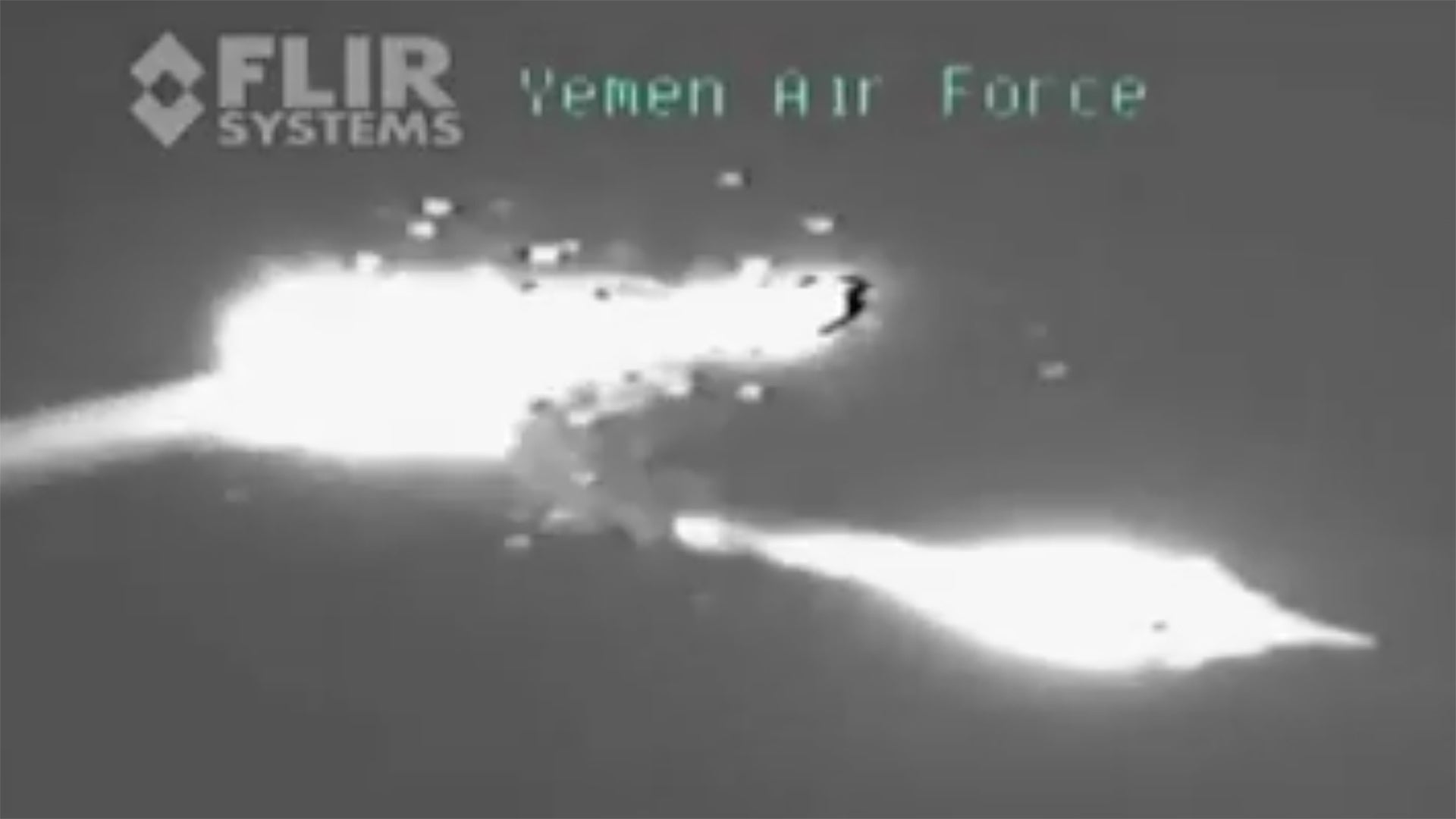Houthi rebels have released video they claim shows the exact moment they shot down Royal Saudi Air Force F-15S over Yemen. The Iranian-supported militants appear to have at least tracked the jet using a repurposed FLIR Systems Star SAFIRE sensor turret, which features an infrared camera.
On Jan. 8, 2018, the Houthis released the infrared video footage, which shows the FLIR Systems logo in the frame, via its Al Masirah television network. A separate statement from the group’s Saba News Agency says their forces shot down the aircraft with an unspecified surface-to-air missile. The complete video also shows the sensor turret on an improvised ground mount. The F-15S fighter appears to increase speed and releases decoy flares before a projectile hits it, appearing to cause significant damage. The fate of the pilots is unknown at this time.
The Houthis say this is separate from a claim they made on Jan. 7, 2018, about having downed a Saudi Tornado swing-wing attack aircraft. The Saudi state-run news agency SPA confirmed that crash, but said it was the result of a technical fault, not enemy action. The Saudi-led coalition recovered the aircraft’s two pilots in that incident.

In October 2017, the Houthis shot down a U.S. Air Force MQ-9 Reaper drone flying over Yemen. That incident reportedly involved a shoulder-fired man-portable air-defense system, or MANPADS.
UPDATE: 3:00pm PST—
There is a distinct possibility that the United States might have supplied the FLIR Systems turret the Yemenis claimed to have employed during this shoot down. In July 2009, the Defense Security Cooperation Agency, the Pentagon’s main arms broker, approved a so-called Pseudo-Foreign Military Sales, or Pseudo-FMS, deal that included three Ultra 8500 turrets “or equivalent,” as well as other equipment and contractor support.
The full package, intended as an upgrade for Yemen’s Huey II helicopters, had an estimated value of more than $3.7 million. The Ultra 8500s by themselves were worth more than $600,000 apiece.

We do not know for sure if the Yemeni government took delivery of this equipment, though. Under the Pseudo-FMS process, the recipient does not have to sign anything in order to accept the aid and the Pentagon treats the arrangement as an internal transfer. The U.S. government crafted the process in 2006 as a means to speed up the delivery of certain types of equipment to allies and partners, particularly those engaged in fighting terrorist groups.

If this turns out to be the case, it would be embarrassing for the United States, as well as FLIR Systems to a lesser degree. There is already evidence that the Houthis have been able to acquire other U.S.-government supplied arms and equipment, including .50 caliber Barrett M82 anti-materiel rifles.

Otherwise, there is still relatively little information about what weapon the Houthis might have used or how they linked the FLIR turret directly to that system, if at all. Just using the sensor to track and monitor aircraft from the Saudi-led coalition, as well as film the engagements for propaganda purposes, would be a relatively simply affair.
There is the possibility that militants used a MANPADS system, as they claimed in the case of the MQ-9 shoot down in October 2017. It is also possible that the Houthis may have repurposed infrared homing air-to-air missiles they captured from Yemeni government stockpiles or obtained from other sources into surface-to-air missiles.
There would be some historical precedent for the latter type of improvised air defense system. Serbian forces employed modified Soviet AA-8 and AA-11 types during the fighting in the Balkans during the 1990s.
The Houthis also claim to have reactivated at least one SA-2 Guideline surface-to-air missile system, including its Fan Song fire control radar. The group said it used one of these radio command guided weapons to knock down an American drone in January 2016, but this claim remains unsubstantiated. They may have also employed one of these missiles in their claimed shoot down of a Sudanese Su-24 Fencer attack aircraft in 2015.
The use of a radar guided missile like the SA-2 would help explain why the missile was not confused by the release of decoy flares, and the reason that the aircrew eventually pushed the jet into a much higher thrust state even though doing so created a far larger infrared signature for a heat-seeking missile to home in on.
In other words, the F-15’s crew may have been confused as to what type of threat it actually wise. Eventually, warnings in the cockpit from the aircraft’s radar warning receiver (RWR) would have also indicated that the missile was radar-guided. All this could have caught the pilots very off guard if they were loitering near or above the MANPADS envelope in an area where there really wasn’t supposed to be a standing threat from radar-guided SAMs.
The video also does not show what happened to the F-15S after the apparent impact, so it is impossible to discern a potential weapon from the resulting damage. In 2015, the Houthis claimed to have shot down another Saudi F-15, but could only present photographs of a damaged AIM-9 Sidewinder air-to-air missile, a drop tank, and a pylon as proof.
This led some to suggest that the rebels had at best damaged the aircraft rather than shot it down. The Saudis did not confirm or deny that incident had occurred.
We will continue to update this post as more information becomes available.
Contact the author: Tyler@thedrive.com
